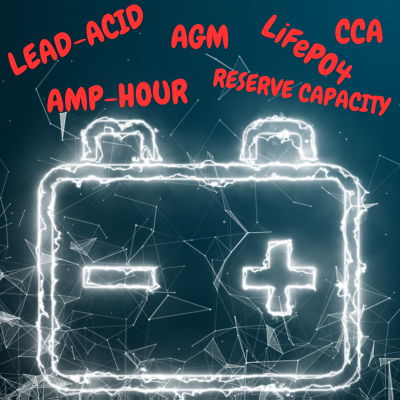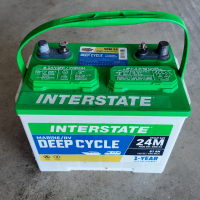RV Batteries 101
- Just CAMP Wait
- Mar 22
- 7 min read
Updated: Mar 26

Batteries are essential to the operation and function of your RV and yet they are often one of the most neglected components. We often take for granted the fact that half of the electrical system in our RVs are dependent on our batteries including the propane furnace, interior lights, tankless water heaters, 12-volt refrigerators, leveling systems, slides, water pump, and the list goes on and on. Needless to say, battery issues can derail an otherwise great camping trip pretty quickly. In this article we'll take a look at the general maintenance requirements and the various types of RV batteries.
I want to start by talking about safety. First and foremost, this is a generalized guide and you should always consult the battery manufacture's manual or a professional if you are unsure about what you're doing. Let's go down a list of general safety guidelines that you should be aware of.
Always wear protective equipment including safety goggles when servicing batteries. Lead-acid batteries contain sulfuric acid which can be hazardous to both people and materials.
Avoid servicing, charging, or using a battery showing any signs of damage such as bulging, cracks, missing components, or overheating.
Avoid short-circuits by removing any jewelry, using insulated tools, and ensuring wiring does not touch any conductive materials or objects. Short circuiting a battery could result in a fire or explosion.
Lead-acid batteries vent hydrogen gas when being charged and should only be serviced in a well-ventilated area that is free from ignition sources.
Always follow the manufacturer's use and care guide for your specific battery.
Battery Categories
Generally, there are two kinds of automotive batteries that we're focusing on with an RV: Starting Batteries and Deep-Cycle Batteries. They are designed to accomplish two different tasks and you need to make sure you select the correct type for your application.
Starting batteries are designed to provide short bursts of high amperage for starting engines. You'll most likely find this type of battery in a motorized RV or on a generator. Deep-cycle batteries are designed for constant moderate amperage loads and longer discharge cycles. These are the batteries you find on most travel trailers and are the "house" batteries on motorized RVs. Without getting too deep into the technical side of battery construction, just know that both types of batteries have different internal plate designs and they are not interchangeable in application. A starting battery used for continuous moderate loads and deep drawdowns will fail and have an extremely short lifespan. Likewise, a deep-cycle battery can't produce enough amperage for starting purposes and will fail from being overloaded and possibly cause catastrophic damage. There are also some manufactures making dual purpose batteries as well which do neither job extremely well but are capable of both functions.
You will also notice two different types of ratings used on starting and deep-cycle batteries. Starting batteries are primarily rated by cold cranking amps (CCA). CCA refers to how many amps the battery can provide at 0°F for 30 seconds. Deep-cycle batteries are more typically rated in amp-hours (Ah) or reserve minutes (RM). Ah refers to how many amps the battery can provide over one-hour. A 10 Ah battery can provide 10 amps for one hour or 5 amps for two hours. RM refers to how many minutes the battery can sustain a 25-amp load. You will sometimes see reserve minutes also referred to as reserve capacity. You can convert RM to Ah with a simple formula if needed: Ah = (RM/60) x 25
Flooded Lead-Acid (FLA) Batteries
Flooded lead-acid batteries are what most of us think of when we picture an automotive battery. The are constructed of many lead plates in a plastic case that is filled with electrolyte (battery acid). The chemical reaction between the plates and the electrolyte is what allows the battery to produce or store electricity. Most have removeable vent-caps that allow the battery to vent fumes when charging and for servicing of the electrolyte. Others are sealed or maintenance-free in which there is typically a pressure-controlled valve built into the case for venting, but the electrolyte is not serviceable. Don't be fooled into thinking maintenance-free flooded lead-acid batteries don't vent at least some harmful fumes. All FLA batteries do by the nature of the chemical reactions that allow them to work.

Benefits of Flooded Lead-Acid Batteries
Simple and reliable design
Cost effective
Common and easy to find
Drawbacks of Flooded Lead-Acid Batteries
Weight to Ah or CCA - They are heavy
Vents harmful fumes
Spillable - Must be kept up-right and secured
Can be damaged if discharged below 50% capacity
Maintenance of Flooded Lead-Acid Batteries
Ensure the battery is clean and free of damage. Debris around the battery can lead to a short-circuit event. Any damage or bulging of the battery can be dangerous and the battery should be safely removed from service.
Ensure the battery is free from corrosion on and around the terminals. To clean the terminals or any visible battery acid spillage, use a mix of baking soda and water or a quality battery cleaner spray. These methods will neutralize any leaked acid or corrosion.
Inspect the electrolyte level. If equipped with removable vent caps, remove the vent caps and ensure that the electrolyte is covering the lead plates. If needed, add distilled water (do not use tap water or bottled water). The level should be 1/4" from the bottom of the vent well tube. Do not overfill the battery cells. The use of a battery filler tool will give you more control when filling the battery. Reinstall the vent caps.
Inspect all connections and wiring. Tighten any loose connections. Be sure not to overtighten electrical connections. They should be tight enough that they will not move or come loose, but not so tight as to bend or smash any connectors.
Absorbent Glass Mat (AGM) Batteries
Absorbent Glass Mat or AGM batteries work off the same principles as FLA batteries. The primary difference is that AGM batteries use an absorbent mat between the lead plates that hold the battery acid so it can't move around in the battery. This makes the battery less prone to damage from vibration, protects the plates better during deep discharge cycles, and reduces the evaporation and venting of the electrolyte. AGM batteries are valve-regulated and sealed with many versions being able to be placed in different positions aside from upright without issue and limiting the venting of fumes to virtually nothing. AGM batteries generally have more plates in them than a similar size FLA battery allowing it to produce more power.
Benefits of Absorbent Glass Mat Batteries
Longer lifespan than FLA batteries
Vibration and damage resistant
Provide more power than FLA batteries
Direct replacement for FLA batteries
Drawbacks of Absorbent Glass Mat Batteries
Weight to Ah or CCA - They are heavy
Cost more than FLA batteries
Can be damaged if discharged below 50% capacity
Maintenance of Absorbent Glass Mat Batteries
Ensure the battery is clean and free of damage. Debris around the battery can lead to a short-circuit event. Any damage or bulging of the battery can be dangerous and the battery should be safely removed from service.
Ensure the battery is free from corrosion on and around the terminals.
Inspect all connections and wiring. Tighten any loose connections. Be sure not to overtighten electrical connections. They should be tight enough that they will not move or come loose, but not so tight as to bend or smash any connectors.
Lithium Iron Phosphate (LiFePO4) Batteries
Lithium Iron Phosphate batteries are a relatively new technology that uses solid state cells to produce and store electricity. Most lithium batteries are constructed of individual cells wired to an internally mounted battery management system (BMS) and packed in a plastic case. The BMS manages the cells and provides safety features such as cell balancing, over temperature protection, short-circuit protection, and some models offer cold temperature cutoff protection or internal batter heaters. These batteries have a long lifespan of over 10 years and are light weight. Due to their power density, they offer more power than similar sized FLA or AGM batteries. They do not vent any harmful fumes. They can also be discharged safely to 100% of capacity.
One thing to be aware of is that lithium batteries operate at 14.6 volts when at full charge which is safe for most modern electronics but also requires a lithium compatible charger since chargers for FLA and AGM batteries operate at a lower voltage and have features specific to that design which can be harmful to lithium batteries. This means you'll need to check the manual for your RV's converter to be sure its lithium compatible or replace it if it's not. If you have onboard solar, you'll need to change your solar charge controller to its lithium charging profile.
Lithium batteries will discharge below 32°F but charging them below 32°F will damage them causing reduced capacity due to buildup on the cell anodes. This is an important consideration if your batteries will be housed outside of a heated space. Many BMSs now come with what is called low-temp protection which stops the battery from charging once the temperature gets too low but will allow it to continue to discharge. Another option is to buy a heated battery which has an internal heater that will allow the battery to warm itself up when it gets too cold.

Benefits of Lithium Iron Phosphate Batteries
10+ year lifespan
Vibration and damage resistant
Lightweight
Doesn't vent harmful fumes
Safely discharge to 100% of capacity
Drawbacks of Lithium Iron Phosphates Batteries
Charging below 32°F can damage them without internal heaters
Cost more than FLA and AGM batteries
Requires a compatible charger and/or converter
Maintenance of Lithium Iron Phosphate Batteries
Ensure the battery is clean and free of damage. Debris around the battery can lead to a short-circuit event. Any damage or bulging of the battery can be dangerous and the battery should be safely removed from service.
Ensure the battery is free from corrosion on and around the terminals.
Inspect all connections and wiring. Tighten any loose connections. Be sure not to overtighten electrical connections. They should be tight enough that they will not move or come loose, but not so tight as to bend or smash any connectors.
Recommended Products From This Article
Weize LiFePO4 Batteries
Weize AGM Batteries
Power Queen LiFePO4 Batteries
Spartan Power Battery Cables
Battery Electrolyte Filler
NOCO Battery Charger
E404 Battery Cleaner Spray
Just CAMP Wait is supported by its audience. When you purchase through links on our site, we may earn an affiliate commission at no extra cost to you. We provide editorial content independently and your support keeps this site up and running.






